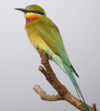INTRODUCTION
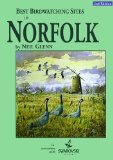 Deciding to take advantage of the cheap offers available from time to time from Travel Lodge we planned five nights away early in April to try and catch up with some East Anglian specialities and early spring migrants.
Deciding to take advantage of the cheap offers available from time to time from Travel Lodge we planned five nights away early in April to try and catch up with some East Anglian specialities and early spring migrants.
Do not travel without……Best Birdwatching Sites in Norfolk by Neil Glenn and Where to Watch Birds in East Anglia
by Neil Glenn and Where to Watch Birds in East Anglia by Peter and Margaret Clarke.
by Peter and Margaret Clarke.
ITINERARY and DIARY
Monday 12th April – We headed south via the A1 to visit Paxton Pits on our way to try for Nightingale. As we were meeting up with our friends Pat & Judy from Stratford we only stayed for about an hour, during which time we failed in our quest, although the air was rife with the songs of Chiffchaff, Willow Warbler and Blackcap. We also saw 2 Red-crested Pochard amongst the numerous waterfowl and eventually caught up with a very vocal Green Woodpecker. A very confiding Robin perched next to me as I sat on a bench waiting for a burst of Nightingale song. We travelled on to Sandringham by mid afternoon and, despite two stops at Wolferton Triangle, failed to catch up with Golden Pheasant (do they really exist I ask myself?). We checked in to the Travel Lodge at Long Sutton, King’s Lynn for the next three nights and later went into the nearby village for dinner at The Granary Hotel. Both service and food were good. HOWEVER... we returned to the Granary in September 2012 and the food was cold, poorly presented and almost inedible; the staff were not much better either. What a difference two years can make. We will not be going back!
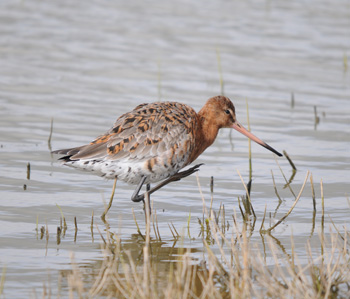 Tuesday 13th April – Although we were up at 07.00hrs we took our time, had a leisurely breakfast and arrived at RSPB Titchwell Marsh at around 09.45hrs after picking up Pat & Judy at Sandringham. Although the sun was shining there was a brisk northerly wind which kept temperatures down to c8° and as a result, although we were wrapped up in our winter birding gear, we didn’t linger once we reached the shoreline. A few small flocks of Dark-bellied Brent Geese lingered on the marsh and pools and a pair of Red-crested Pochard were joined by two Spotted Redshank amongst the numerous Common Redshank; whilst several early Sedge Warbler sang from the reeds. Good numbers of Blackcap were calling as Marsh Harrier drifted by overhead. After an excellent lunch at The Lifeboat Inn at Thornham we moved on to Holkham in search of a dozen or so lingering Shore Lark at the end of Lady Anne’s Drive, but with the beach and saltings over run by dog walkers and tourists the only birds we were able to pick up were 20 or so Skylark. Undeterred, we returned to the car park and set off into the woods, out of the wind, for the George Washington hide in the Holkham Pines NNR. We spotted Long-tailed Tit and Goldcrest along the way and from the hide, which gives an elevated view over the marsh, we saw a pair of Marsh Harrier, a lone Egyptian Goose and a small flock of Swallow. By late afternoon we arrived at NWT Cley Marshes hoping for a cup of tea; but with last orders in the café at 16.15hrs, no potential new birds reported on the reserve and the strong northerly wind making birdwatching unpleasant, we moved on to NWT Salthouse Marshes in the hope of picking up a Barn Owl with a little bit of “armchair” birding from the car. We have been here on numerous occasions previously and have never failed, but this was to be a first! In fact we failed to pick up Barn Owl during the whole trip, even at Holme, a first for Norfolk for us. With the weather deteriorating and a few spots of rain falling, we only managed a pair of Ringed Plover and c12 Turnstone on the small pools between the marsh and the shingle bank at the back of the car park. On the way back to Sandringham on the A148 we passed The Crown Inn at East Rudham and decided to try it for dinner. As we were early (18.45hrs) we were lucky to get a table, which was only booked for 20.00hrs, as a local function was taking up two thirds of the restaurant. The food is really excellent, reasonably priced and sufficiently different to make it well worth a visit, but I would suggest booking (Tel: 01485 528530) rather than being disappointed.
Tuesday 13th April – Although we were up at 07.00hrs we took our time, had a leisurely breakfast and arrived at RSPB Titchwell Marsh at around 09.45hrs after picking up Pat & Judy at Sandringham. Although the sun was shining there was a brisk northerly wind which kept temperatures down to c8° and as a result, although we were wrapped up in our winter birding gear, we didn’t linger once we reached the shoreline. A few small flocks of Dark-bellied Brent Geese lingered on the marsh and pools and a pair of Red-crested Pochard were joined by two Spotted Redshank amongst the numerous Common Redshank; whilst several early Sedge Warbler sang from the reeds. Good numbers of Blackcap were calling as Marsh Harrier drifted by overhead. After an excellent lunch at The Lifeboat Inn at Thornham we moved on to Holkham in search of a dozen or so lingering Shore Lark at the end of Lady Anne’s Drive, but with the beach and saltings over run by dog walkers and tourists the only birds we were able to pick up were 20 or so Skylark. Undeterred, we returned to the car park and set off into the woods, out of the wind, for the George Washington hide in the Holkham Pines NNR. We spotted Long-tailed Tit and Goldcrest along the way and from the hide, which gives an elevated view over the marsh, we saw a pair of Marsh Harrier, a lone Egyptian Goose and a small flock of Swallow. By late afternoon we arrived at NWT Cley Marshes hoping for a cup of tea; but with last orders in the café at 16.15hrs, no potential new birds reported on the reserve and the strong northerly wind making birdwatching unpleasant, we moved on to NWT Salthouse Marshes in the hope of picking up a Barn Owl with a little bit of “armchair” birding from the car. We have been here on numerous occasions previously and have never failed, but this was to be a first! In fact we failed to pick up Barn Owl during the whole trip, even at Holme, a first for Norfolk for us. With the weather deteriorating and a few spots of rain falling, we only managed a pair of Ringed Plover and c12 Turnstone on the small pools between the marsh and the shingle bank at the back of the car park. On the way back to Sandringham on the A148 we passed The Crown Inn at East Rudham and decided to try it for dinner. As we were early (18.45hrs) we were lucky to get a table, which was only booked for 20.00hrs, as a local function was taking up two thirds of the restaurant. The food is really excellent, reasonably priced and sufficiently different to make it well worth a visit, but I would suggest booking (Tel: 01485 528530) rather than being disappointed.
Wednesday 14th April – Today we decided to start off at Sculthorpe Moor in search of Golden Pheasant and Goshawk. Unfortunately, the latter, although seen regularly earlier in the year, appeared to have been displaced by the returning Marsh Harrier pairs two or three weeks earlier. 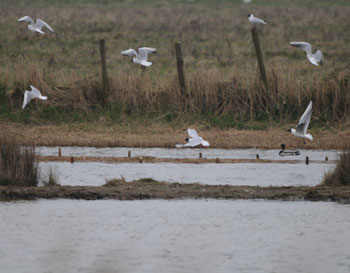 We were luckier with the Golden Pheasant, although the unmistakable male insisted on preening and calling from within a large Holly bush and only giving restricted views of his finery. Otherwise the site was very quiet. Recent management by the local community in conjunction with The Hawk & Owl Trust is improving this small (42 acres) but varied site, which shows good potential for the future. On the way back to the coast we stopped at The King William IV Country Inn and Restaurant at Sedgeford near Hunstanton for a delightful lunch. The food was excellent but unfortunately the staff were a little surly. Perhaps we caught them on a bad day! After lunch we moved on to NWT Holme Dunes, where a Kentish Plover had caused quite a stir on the beach the previous day. The reserve was fairly quiet with the main highlight being a pair of Mediterranean Gull which dropped in for a short while and a lingering flock of c150 Pinkfoot. We briefly visited RSPB Snettisham, but faced with a round trip of over 3 miles from the car park to the hides and the attendant wader roost, we decided to give it a miss as it was now 16.30hrs and still blowing a gale. Before leaving we did spot a pair of Egyptian Goose and c10 young in the fields near the car park. Returning to Sandringham once again we briefly visited Wolferton Triangle, but with nothing doing, we moved on to the excellent little site at Abbey Farm Flitcham, where we managed to miss the resident nesting Kingfisher and Little Owl. Not to be deterred we returned to The Crown Inn, having booked a table the previous night, to enjoy another excellent meal.
We were luckier with the Golden Pheasant, although the unmistakable male insisted on preening and calling from within a large Holly bush and only giving restricted views of his finery. Otherwise the site was very quiet. Recent management by the local community in conjunction with The Hawk & Owl Trust is improving this small (42 acres) but varied site, which shows good potential for the future. On the way back to the coast we stopped at The King William IV Country Inn and Restaurant at Sedgeford near Hunstanton for a delightful lunch. The food was excellent but unfortunately the staff were a little surly. Perhaps we caught them on a bad day! After lunch we moved on to NWT Holme Dunes, where a Kentish Plover had caused quite a stir on the beach the previous day. The reserve was fairly quiet with the main highlight being a pair of Mediterranean Gull which dropped in for a short while and a lingering flock of c150 Pinkfoot. We briefly visited RSPB Snettisham, but faced with a round trip of over 3 miles from the car park to the hides and the attendant wader roost, we decided to give it a miss as it was now 16.30hrs and still blowing a gale. Before leaving we did spot a pair of Egyptian Goose and c10 young in the fields near the car park. Returning to Sandringham once again we briefly visited Wolferton Triangle, but with nothing doing, we moved on to the excellent little site at Abbey Farm Flitcham, where we managed to miss the resident nesting Kingfisher and Little Owl. Not to be deterred we returned to The Crown Inn, having booked a table the previous night, to enjoy another excellent meal.
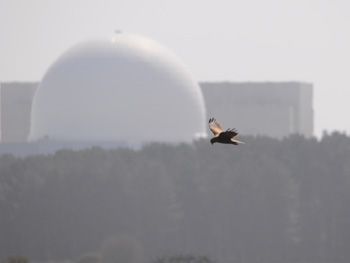 Thursday 15th April – Leaving Long Sutton and the north coast we travelled south to NWT Weeting Heath where we saw a distant pair of Stone Curlew at their nest scrape. As we were advised the Woodlark were not yet very visible we moved on to RSPB Lakenheath Fen and immediately connected with Garganey on the flash across the Little Ouse River, along with a good selection of waterfowl, including Wigeon. We then walked the 1½ miles to the furthest watchpoint in the hope of seeing one of the two resident pair of Crane or the previous year’s juvenile, but despite scanning the area for 45 minutes all we managed to see of note were quartering Marsh Harrier and about 1.5 seconds of Bittern in flight. Along the walk we heard (but didn’t see) Cetti’s Warbler, Bearded Tit and Grasshopper Warbler. Sadly, we knew we were too early for the site specialities of Hobby and Golden Oriole. Moving on we visited Bressingham Gardens for a spot of light relief and travelled onwards to the Travel Lodge at Ipswich Beacon Hill where we checked in for two nights. We decided to try the nearby RSPB Wolves Wood site; a promising 92 acres of mixed woodland which we had never visited before. By now it was 17.15hrs and unfortunately the car park is gated and locked from 18.00hrs to 09.00hrs so we briefly explored the nearest track for 45 minutes. We saw Marsh Tit along with several Willow Warbler, Chiffchaff and Blackcap. Not wishing to venture into Ipswich just to eat, we found a nearby Pizza Hut for dinner – you get what you pay for unfortunately, but at least we knew what to expect.
Thursday 15th April – Leaving Long Sutton and the north coast we travelled south to NWT Weeting Heath where we saw a distant pair of Stone Curlew at their nest scrape. As we were advised the Woodlark were not yet very visible we moved on to RSPB Lakenheath Fen and immediately connected with Garganey on the flash across the Little Ouse River, along with a good selection of waterfowl, including Wigeon. We then walked the 1½ miles to the furthest watchpoint in the hope of seeing one of the two resident pair of Crane or the previous year’s juvenile, but despite scanning the area for 45 minutes all we managed to see of note were quartering Marsh Harrier and about 1.5 seconds of Bittern in flight. Along the walk we heard (but didn’t see) Cetti’s Warbler, Bearded Tit and Grasshopper Warbler. Sadly, we knew we were too early for the site specialities of Hobby and Golden Oriole. Moving on we visited Bressingham Gardens for a spot of light relief and travelled onwards to the Travel Lodge at Ipswich Beacon Hill where we checked in for two nights. We decided to try the nearby RSPB Wolves Wood site; a promising 92 acres of mixed woodland which we had never visited before. By now it was 17.15hrs and unfortunately the car park is gated and locked from 18.00hrs to 09.00hrs so we briefly explored the nearest track for 45 minutes. We saw Marsh Tit along with several Willow Warbler, Chiffchaff and Blackcap. Not wishing to venture into Ipswich just to eat, we found a nearby Pizza Hut for dinner – you get what you pay for unfortunately, but at least we knew what to expect.
Friday 16th April – We had reserved today for RSPB Minsmere and, arriving a little after 10.00hrs, found the car park relatively empty for a change. We decided to start off by visiting the hides around The Scrape and amongst others, saw Marsh Harrier, c15 Mediterranean Gull, a single Knot, Ringed Plover, Common Snipe, a substantial flock of Black-tailed Godwit and three Dunlin. 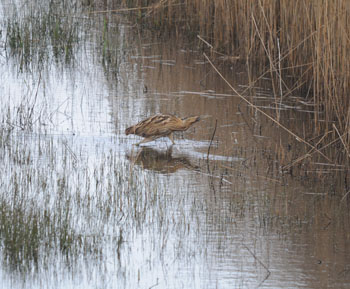 Cetti’s Warbler were bursting forth in song everywhere, but again, we couldn’t manage to locate a single bird. Waterfowl included, Barnacle Goose, Greylag, Shoveler and Gadwall amongst others. After lunch in the Café we decided to walk around the edge of the marsh, visiting the Bittern and Island Mere Hides before returning to the Visitor Centre for afternoon tea, via the woodland and Canopy Hide. As usual the Bittern Hide was packed out with a few photographers and “the rest of us” and typically seats were hogged for ages with people waiting for that “Bittern moment” or the “perfect shot” of a Marsh Harrier. Having waited for a few minutes we were lucky as two people left and we were able to sit down. After about 10 minutes a Bittern appeared about 30 metres away, moving from the reeds on the left across the open water created for just this purpose. The Bittern gave excellent views for about 5 minutes before disappearing into the reeds on the other side of the cut. We decided to take our leave to let others have the chance of a similar experience. From the Island Mere Hide I had a brief view of a Bearded Tit as it called before dropping into the reeds. The only species of note in the woodland section of the walk was Treecreeper near the Canopy Hide. After a refreshing brew and the obligatory slice of cake consumed on the patio overlooking the Sand Martin colony, we visited the North Hide to view the Scrape again with the afternoon sun in just the right position for photography. Returning to the car park we spotted a Wren, giving it all he'd got from a small bush at the side of the path, before we set off for RSPB Westleton Heath in the hope of catching up with Dartford Warbler. Shortly after leaving Minsmere we were surprised to come across c8 Fieldfare feeding alongside a Green Woodpecker in the grassland at the side of the road. The Heath, however, was very quiet apart from a pair of Stonechat and a passing Peregrine. On the way back to the Travel Lodge we stopped at The Griffin in Yoxford for a bite to eat. The food was adequate but you couldn’t get to the bar for “the Locals” who were standing four or five deep. Not very welcoming!
Cetti’s Warbler were bursting forth in song everywhere, but again, we couldn’t manage to locate a single bird. Waterfowl included, Barnacle Goose, Greylag, Shoveler and Gadwall amongst others. After lunch in the Café we decided to walk around the edge of the marsh, visiting the Bittern and Island Mere Hides before returning to the Visitor Centre for afternoon tea, via the woodland and Canopy Hide. As usual the Bittern Hide was packed out with a few photographers and “the rest of us” and typically seats were hogged for ages with people waiting for that “Bittern moment” or the “perfect shot” of a Marsh Harrier. Having waited for a few minutes we were lucky as two people left and we were able to sit down. After about 10 minutes a Bittern appeared about 30 metres away, moving from the reeds on the left across the open water created for just this purpose. The Bittern gave excellent views for about 5 minutes before disappearing into the reeds on the other side of the cut. We decided to take our leave to let others have the chance of a similar experience. From the Island Mere Hide I had a brief view of a Bearded Tit as it called before dropping into the reeds. The only species of note in the woodland section of the walk was Treecreeper near the Canopy Hide. After a refreshing brew and the obligatory slice of cake consumed on the patio overlooking the Sand Martin colony, we visited the North Hide to view the Scrape again with the afternoon sun in just the right position for photography. Returning to the car park we spotted a Wren, giving it all he'd got from a small bush at the side of the path, before we set off for RSPB Westleton Heath in the hope of catching up with Dartford Warbler. Shortly after leaving Minsmere we were surprised to come across c8 Fieldfare feeding alongside a Green Woodpecker in the grassland at the side of the road. The Heath, however, was very quiet apart from a pair of Stonechat and a passing Peregrine. On the way back to the Travel Lodge we stopped at The Griffin in Yoxford for a bite to eat. The food was adequate but you couldn’t get to the bar for “the Locals” who were standing four or five deep. Not very welcoming!
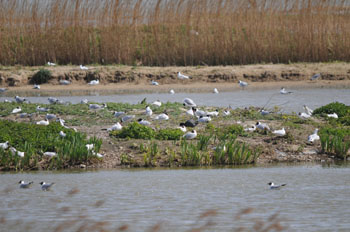 Saturday 17th April - Today we travelled home in a roundabout sort of way, on a beautiful sunny day, which was much warmer as the wind had dropped almost completely. Initially we set off south east to Kent to see our new grandson. On the way, we stopped off at RSPB Rainham Marshes as we were a little early. We only walked a short way in to the reserve, however, we were able to pick up Whitethroat, Lesser Whitethroat (very briefly singing from within the top of a hawthorn bush) and, at long last, Cetti’s Warbler, which, like Blackcap, were singing all around us. Before moving on we decided to have a spot of lunch – big mistake! Some of the catering staff were suffering from the previous night’s excesses, most were standing around just talking and the food was almost inedible, as well as taking an age to arrive (how can you bugger up tomato and basil soup, cheese scone, baked potato and sausages?). What made it worse was that it had barely passed 12.00 noon and the café was almost deserted: this was quite literally our worst ever food experience at an RSPB reserve. I know some of the staff are volunteers but this is no excuse and the staff at Rainham could do much worse than take lessons from their colleagues at either Saltholme or Leighton Moss. We then moved on to our ultimate goal, Birchington near Margate and although the binoculars were left in the car, we picked up another new bird for the trip with 3 Ring-necked Parakeet. At 16.00hrs we set off north again and despite a frustrating delay of c1hour on the M25 (surprise, surprise!) we made time for another detour to Paxton Pits, hoping the warmer, calmer weather might encourage Nightingale to perform. We were not too hopeful as several people we met had heard no song at all. However we went to the area around the Kingfisher Hide, where a bird had been reported the previous weekend and within 5 minutes were listening to the beautiful sound of Nightingale song emanating from a hawthorn bush at the side of the path. Despite sounding near enough to touch, had I stretched my arm out into the bush, I was unable to locate the little blighter. Amanda was luckier, as she remained on the other side of the bush and the bird briefly dashed out and back again.
Saturday 17th April - Today we travelled home in a roundabout sort of way, on a beautiful sunny day, which was much warmer as the wind had dropped almost completely. Initially we set off south east to Kent to see our new grandson. On the way, we stopped off at RSPB Rainham Marshes as we were a little early. We only walked a short way in to the reserve, however, we were able to pick up Whitethroat, Lesser Whitethroat (very briefly singing from within the top of a hawthorn bush) and, at long last, Cetti’s Warbler, which, like Blackcap, were singing all around us. Before moving on we decided to have a spot of lunch – big mistake! Some of the catering staff were suffering from the previous night’s excesses, most were standing around just talking and the food was almost inedible, as well as taking an age to arrive (how can you bugger up tomato and basil soup, cheese scone, baked potato and sausages?). What made it worse was that it had barely passed 12.00 noon and the café was almost deserted: this was quite literally our worst ever food experience at an RSPB reserve. I know some of the staff are volunteers but this is no excuse and the staff at Rainham could do much worse than take lessons from their colleagues at either Saltholme or Leighton Moss. We then moved on to our ultimate goal, Birchington near Margate and although the binoculars were left in the car, we picked up another new bird for the trip with 3 Ring-necked Parakeet. At 16.00hrs we set off north again and despite a frustrating delay of c1hour on the M25 (surprise, surprise!) we made time for another detour to Paxton Pits, hoping the warmer, calmer weather might encourage Nightingale to perform. We were not too hopeful as several people we met had heard no song at all. However we went to the area around the Kingfisher Hide, where a bird had been reported the previous weekend and within 5 minutes were listening to the beautiful sound of Nightingale song emanating from a hawthorn bush at the side of the path. Despite sounding near enough to touch, had I stretched my arm out into the bush, I was unable to locate the little blighter. Amanda was luckier, as she remained on the other side of the bush and the bird briefly dashed out and back again.
SUMMARY
 With Travel Lodges you do not get the lap of luxury, but you do know what you are going to get and if you plan ahead, at a very reasonable price. The lodges we stayed in were both clean and the staff were very friendly and helpful. They served their purpose very well, although not really ideally located for proximity to the birding sites we visited (King’s Lynn, Long Sutton is about 34 miles/1 hour from Titchwell and Ipswich Beacon Hill is almost a similar distance/time from Minsmere). Despite a litany of missed or heard only species, we managed to catch up with some of our targets and recorded 105 species with a further 3 heard only. The cold spring weather seemed to have slowed down migration a little this year and as a result we didn’t catch up with as many migrants as we hoped for – perhaps we would have benefitted from making the trip 2 weeks later; but we’ll be back.
With Travel Lodges you do not get the lap of luxury, but you do know what you are going to get and if you plan ahead, at a very reasonable price. The lodges we stayed in were both clean and the staff were very friendly and helpful. They served their purpose very well, although not really ideally located for proximity to the birding sites we visited (King’s Lynn, Long Sutton is about 34 miles/1 hour from Titchwell and Ipswich Beacon Hill is almost a similar distance/time from Minsmere). Despite a litany of missed or heard only species, we managed to catch up with some of our targets and recorded 105 species with a further 3 heard only. The cold spring weather seemed to have slowed down migration a little this year and as a result we didn’t catch up with as many migrants as we hoped for – perhaps we would have benefitted from making the trip 2 weeks later; but we’ll be back.
Bird Species List
David & Amanda Mason
